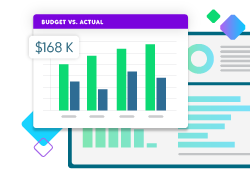The Final Step of the Audit: Helping Your Board Understand the Nonprofit Audit Report

Congratulations on another successful financial audit! Making it through with minimal headaches is a testament to planning, partnership with your Program team, and strong internal processes and procedures.
Now that all the outstanding entries have been cleared and reports have been pulled, the last step of the nonprofit audit is to present your audited financial statements and the shiny, clean opinion letter to the board.
These presentations are often mind-numbingly boring. You have spent countless hours organizing footnotes and grouping the line items on the financial statements to effectively tell your story. Your auditors march the board through the report, ultimately saying that you were cooperative, and the opinion is clean.
All in all, it is anticlimactic for everyone. During the year, you will likely have your own management reports that focus on programmatic and financial outcomes. The presentation for the GAAP financial statement gets pranced out once a year like a birthday cake.
The auditors have a responsibility to ensure that the board understands the GAAP financial statements and the implications of the opinion letter. If your board only sees that format once a year, the time needs to be spent on the basics of the statement instead of the details of the audit result.
Help your board feel empowered to ask educated questions by giving them more experience with the GAAP statements throughout the year, and not just during the audit presentation.
Sharing Your Nonprofit Audit Report Format More Than Once a Year
What if you used your accounting software to punch out your GAAP financial statement and the key footnotes on a quarterly basis? This way you are providing your board, executive leadership, and lending institutions with a true GAAP financial statement. Any accounting software worth its salt can provide the management reports and GAAP financial statement directly from the software—not through a labyrinth of Excel spreadsheets.
Presenting these reports more regularly helps your board members and leadership feel more comfortable with the information, instead of trying to remember each year why it might be different from your regular reports.
3 Reasons to Share GAAP Financial Statements Quarterly
Better Reflects Your Organization: This approach provides an opportunity for you to make sure that your GAAP financial statement presentation mirrors what is actually happening in your current organization.
Saves Time: Running the report quarterly avoids the massive rewrite of various statements within your GAAP reporting while finalizing the audit.
Provides More Transparency: Presenting the reports quarterly also provides your leadership with the ability to speak with continuity during the year in a consistent manner. Your Finance Committee members likely know your bankers and funders in the community. It serves you well to arm your advocates with GAAP results and your management reports. You are sharpening their pencils by giving them the information they need to speak on your organization’s behalf.
Empower Your Board with an Understanding of GAAP Reporting
Your mind-numbing annual audit report presentation now can become a dialogue! Your board members have had time to see the evolution of the GAAP financial results throughout the year. This provides a forum for the Board to talk about the impact of these financial results and trends.
The auditors also have an opportunity to speak to your program results and internal controls. This is a win for everyone. The Board can feel informed and comfortable representing you to their constituents and program leadership can see how the audit reinforces the good work that they do. At the end of the day, you are all here for the mission that your Program team delivers!
To learn more about how to set your organization up for audit success, check out our webinar with Paul Preziotti, CPA, Partner, Johnson Lambert, Audit Readiness: How to Ace Preparation for Your Financial Statement Audit.
This post was originally posted in June 2017 and updated in June 2023.
Fund Accounting Software that Drives Impact
Find out how Blackbaud’s Financial Edge NXT® fits your organization.


